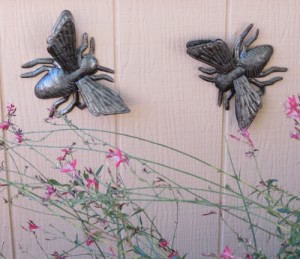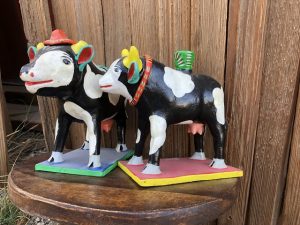April 30, 2014

Bring home the honey, Honey! LE3602 “Bees on a Vine” by Jean Sylvionel Brutus
Honey has always been in great demand in Haiti and there was a time when the island country’s needs were met by local beekeeping. However, political upheaval, environmental degradation, and a bee blight combined for a triple whammy that nearly killed Haitian production. Those beekeepers that continued to struggle on did not have access to information or tools which would allow them to maximize production and in fact, it is something of a miracle that they were able to harvest honey at all under the circumstances. Most beekeepers were reduced to not using hives, but rather tending to the bees wherever they happened to build their nests. Others were managing their bees in traditional hollow log hives, harvesting the honey by smoking the bees out and then removing the honey after the bees left. Though that method is inexpensive for the beekeeper, the honey retains a smoky taste and the farmer is unable to check brood health without damaging the comb. A sorry state of affairs no matter how you slice it.
Enter Farmer to Farmer, a program administered by Partners of the Americas and Funded by USAID. Farmer to Farmer set out to reestablish the once thriving beekeeping industry in the country by sending successful beekeepers and agriculturists from the United States to Haiti. Their goals were simple: train young Haitians to work in the industry; help transition old hives to more modern ones; and educate beekeepers about disease, production and processing. As a result of their efforts, many Haitians are producing enough honey for their own communities with plenty of extra to sell to others. Just one year after the Farmer to Farmer program began its work, more than 1,000 beekeepers returned to raising bees and more than 300 hives were restructured. Honey production has increased from three to seven gallons per hive, generating significant income for Haitian beekeepers. In addition, beekeepers are now communicating with each another and forming beekeeping associations, recognizing the need to organize in order to increase profits and reduce costs.
The amber liquid along with other hive products like propolis hold countless health benefits, which make producing it an ideal industry for impoverished nations. It has antibacterial properties that make it an effective topical agent for wounds. It is used as a skin care product, a sweetener for foods and beverages, and as a treatment to take the sting out of sore throats. The honey business has also provided micro-enterprise opportunities for women in Haiti who use the beeswax to make candles and crafts for sale.
Meghan Oliver, a program officer of the Farmer to Farmer Beekeeping Project believes that revitalizing local enterprise is a key ingredient in eliminating the cycle of poverty in countries such as Haiti. In the case of reviving honey production, she says, “Increasing cash in the hands of poor farmers is going to empower them immeasurably. The money they earn can be spent on their most important needs, whether it’s a generator for electricity, for repairs to their home or school fees for their kids. The best thing is that THEY earn and THEY decide.”
Contributed by Linda for Beyond Borders/It’s Cactus





